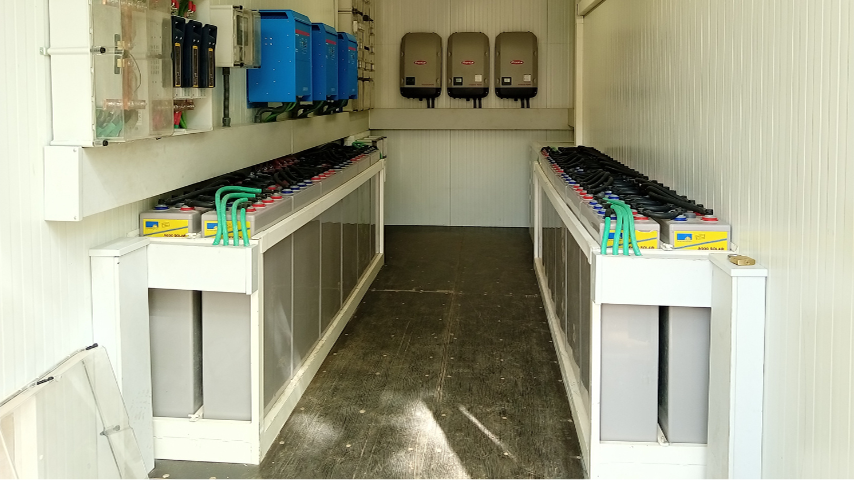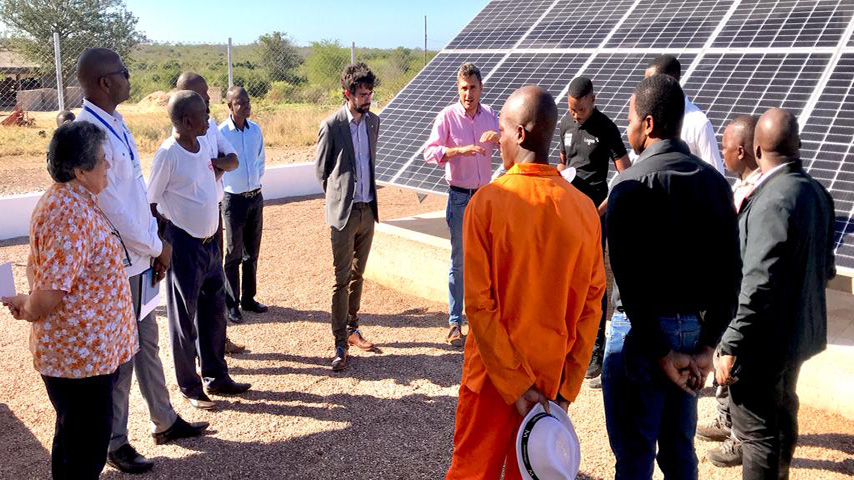Why should we install solar hybrid system?
Why should we install solar hybrid system in Africa?
The Role of Batteries in Solar Hybrid Systems:
In recent years, electrochemical storage systems have emerged as significant players in the energy transition, alongside renewable sources. Unlike other conventional storage systems such as mechanical, thermal, or chemical, electrochemical storage offers several advantages, including high energy and power density, competitive market prices, and the ability to support continuous charge and discharge applications. Due to their scalability and flexibility, electrochemical batteries have become ubiquitous in our daily lives, powering portable appliances ranging from mobile phones to tablets or laptops. It comes as no surprise that even the automotive sector is transitioning from combustion engines to electric motors, coupled with electrochemical batteries.
In the photovoltaic (PV) sector, batteries have been widely used for the past decade to store excess energy produced by PV panels during sunny hours and utilize it during nighttime. The decision to shift power production to the night can be motivated by various factors, depending on the specific system in place.
In on-grid systems, both at the industrial and residential levels, most installed PV systems do not include batteries. The reason behind this lies in the cost implications. Shifting excess solar energy to the night hours leads to an increase in cost per kilowatt-hour (kWh) and an extended payback period. Providing quantitative examples is challenging as it depends on factors such as electricity bills, scheduled costs, battery prices, and battery capacity. According to our experience in the sector, to double the self-consumption through hybrid system we move from 4-5 years of Pay Back Time, with only the PV, to 9-10 years. For this reason, the majority of the installation is known as “0-injection” or “self-consumption,” where the peak production of the PV system matches the peak load demand.
Addressing Reliability Challenges:
However, if the local grid is unreliable and forces consumers to endure frequent power outages, using batteries becomes a more cost-effective and environmentally friendly solution compared to relying on diesel generators as backups. Industries and hospitals, for instance, benefit from integrating batteries into their systems as it ensures a higher degree of independence from the grid, resulting in a more stable and flexible energy supply. Several situations in Africa have demonstrated the critical need for battery integration, as hospitals were unable to operate in surgical rooms due to grid outages and temporary unavailability of diesel fuel for generators.
Moreover, powering your appliances with your own produced power also has a great advantage in terms of power quality and security. The first is crucial to prevent client appliances, which may be very costly, from being subjected to fluctuating grid power and thus getting spoiled over time. The second improves the resiliency of the industry or hospital in reacting to increases in fossil fuel prices or political instabilities.
Off-Grid Systems:
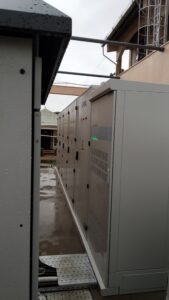
In the specific case of off-grid systems, batteries assume a pivotal role, offering a practical and indispensable solution. Their integration with photovoltaic (PV) technology becomes paramount to ensure an uninterrupted power supply 24 hours a day. These systems go beyond mere economic optimization and are designed to fulfill specific objectives. Depending on the application, the battery can be appropriately sized to meet the load requirements for two or even three consecutive days. Given the unpredictability of solar resources, these systems are consistently hybridized with small diesel generators as a contingency measure during extended periods of rainfall.
Looking Ahead:
In the next blog, we will enter into detail about the available types of batteries (lead-acid, lithium ion, flow batteries …) discussing which ones are preferred in one case and which in the other. Since the importance of storage in the electrification of the production and consumption sectors is well-known, there are always more and more emerging technologies entering the market. We will go through the most popular ones, describing their pros and cons in commercial and industrial applications.
For more information you can read the related article:
Azimut World: commercial & International area
Solar Energy for Hospitals in Sub-Saharian Africa: when does it make sense
Solar Energy for Hospitals & Biomedical Research Centres in Sub-Saharan Africa: When does it make sense?
Solar energy has been growing exponentially worldwide due to its numerous advantages and ability to meet the demands of a growing population. In Sub-Saharan Africa, the need for reliable power in hospitals and biomedical research centres has become increasingly crucial. This article will explore the reasons behind this need, the benefits of solar energy, and the optimal conditions for implementing solar photovoltaic (PV) systems, battery energy storage solutions (BESS), PV + diesel hybrid systems, and solar-powered medical oxygen production.
Why Hospitals and Biomedical Research Centres?
Hospitals and biomedical research centres play a vital role in the health and well-being of people in Sub-Saharan Africa. They are responsible for providing critical medical care, conducting life-saving research, and creating a sustainable healthcare infrastructure. As such, they require continuous, reliable, and efficient power to run their operations and support their mission.
The Need for a Reliable Power Supply
The lack of a reliable power supply in Sub-Saharan Africa poses significant challenges to hospitals and research centres. Frequent power outages disrupt essential services, equipment, and research[1]. This can lead to the loss of valuable data, life-threatening delays in care, and increased operational costs. Moreover, relying on the local grid can subject valuable client appliances to power fluctuations and diminish resilience in response to fuel price hikes or political uncertainties.
The need for a stable and efficient energy source is essential in addressing these challenges and ensuring the effective functioning of healthcare institutions.
The Benefits of Solar Energy
Solar energy offers several benefits for hospitals and biomedical research centres in Sub-Saharan Africa:
- Reliability: Solar energy systems can provide a stable and continuous power supply, reducing the risk of outages and minimizing disruptions to services and research.
- Cost-effectiveness: Solar energy systems have significantly reduced in cost over the past decade. This makes it more affordable for healthcare institutions to invest in solar power.
- Sustainability: Solar energy is a clean, renewable resource that can help reduce greenhouse gas emissions and promote environmentally friendly practices.
- Scalability: Solar energy systems can be easily expanded to meet the growing demands of hospitals and research centres.
- Simplicity and Local Expertise: Solar energy employs simple technology that can be easily maintained and learned by local personnel, reducing dependency on external experts.
- High-Quality Energy: Solar power generation is stable and controlled by advanced technology inverters, ensuring a consistent and high-quality energy supply for critical operations.
When to add Solar PV?
It is important to consider the following factors when deciding when to add solar PV to hospitals and research centres:
- Location: Areas with abundant sunshine and minimal shading are ideal for solar PV installations.
- Energy demand: Understanding the energy consumption patterns of the institution will help determine the appropriate size of the solar PV system.
- Available space: The facility must have enough space for the installation of solar panels and related equipment.
- Financial incentives: Governments and organizations may offer incentives, grants, or tax credits for the installation of solar PV systems, making it more affordable. Ask us more to find out current financing opportunities.
When to add Battery Storage?
Battery storage is useful when:
- Grid instability is prevalent, and backup power is crucial for maintaining essential services and research activities.
- Energy demand fluctuates throughout the day, and the stored energy can be used during peak demand periods.
Enhance the share of renewable energy compared to direct photovoltaic (PV) self-consumption.
Types of Battery Energy Storage Solutions (BESS)
Different chemistries of battery energy storage solutions can be used for hospitals and research centres, including:
- Lead-acid batteries: These are a cost-effective option but have a shorter lifespan and lower energy density compared to other battery types.
- Lithium-ion batteries: They offer a higher energy density, longer lifespan, and better performance but come at a higher cost.
- Flow batteries: These batteries are well-suited for large-scale energy storage and can provide longer discharge durations, but they are more complex and expensive than other options.
Hybridation with the Utility Grid and/or Existing Diesel Gensets
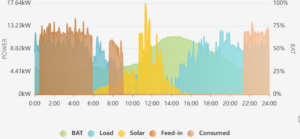
Integrating solar PV systems with the utility grid and/or existing diesel gensets allows for a more stable and flexible power supply. Hybrid systems can optimize energy generation and consumption, reducing reliance on diesel fuel and lowering operational costs. These systems can be designed to prioritize solar power, utilizing grid electricity as a secondary source and resorting to diesel generators only when essential.
Additional uses: Solar Energy for the Production of Medical Oxygen
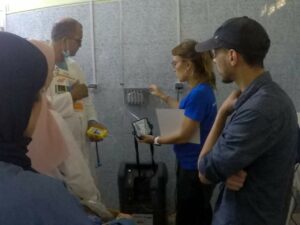 Medical oxygen is essential in hospitals for various treatments and procedures. In many Sub-Saharan African hospitals, oxygen supplies can be unreliable and costly. Solar energy can be used to power medical oxygen production systems, providing a sustainable and cost-effective solution. By harnessing the sun’s energy, hospitals can produce their own oxygen, reducing dependency on external suppliers and ensuring a steady supply for critical healthcare needs.
Medical oxygen is essential in hospitals for various treatments and procedures. In many Sub-Saharan African hospitals, oxygen supplies can be unreliable and costly. Solar energy can be used to power medical oxygen production systems, providing a sustainable and cost-effective solution. By harnessing the sun’s energy, hospitals can produce their own oxygen, reducing dependency on external suppliers and ensuring a steady supply for critical healthcare needs.
Solar energy presents a promising solution for hospitals and biomedical research centres in Sub-Saharan Africa, offering a reliable, cost-effective, and sustainable power source. Assessing the specific needs and circumstances of each institution is crucial in determining the optimal time and method for implementing a solar PV system with or without battery storage or hybridizing with the utility grid or with a genset. By embracing solar energy, healthcare institutions can overcome the challenges of unreliable power supplies and contribute to the long-term development of the region’s healthcare infrastructure.
Are you ready to explore the potential of solar energy for your hospital or biomedical research centre in Sub-Saharan Africa? Our team of experts is here to help you assess your needs, design the optimal solution, and provide a techno-economic proposal.
[1] https://www.news24.com/fin24/Economy/waves-of-blackouts-hit-major-cities-in-ivory-coast-20210505
https://apanews.net/2023/05/02/fuel-shortage-hits-malawi-regulator-blames-logistical-woes/
Azimut World: commercial & International area
Casa de Gaiato and its Commitment to Solar Energy
Casa de Gaiato and its Commitment to Solar Energy
Savings in electrical costs and Training for the new Generations
In the heart of Mozambique’s Maputo province, Casa do Gaiato (CoG) has been a beacon of social support for rural communities for more than three decades. This non-profit organisation, located in the Boane district, has provided a wide range of vital services, from food to education, to orphaned children and needy families in neighbouring villages. With one of the largest and most successful schools in the region, CoG not only provides primary and secondary education, but also provides child pickup services and social support to families.
However, since its inception, this institution has faced a major challenge: the lack of an affordable and reliable electricity supply. As one of the few entities in the area connected to the national grid, CoG has had to bear high electricity bills and, consequently, a financial burden that has reduced its capacity for self-sufficiency. This situation has forced the organization to increasingly depend on external sources of funding to continue its community activities and projects.
But the problem doesn’t end there. The instability and low quality of the electricity supply have had a direct impact on CoG’s daily operations. From the interruption of activities to the frequent repair or replacement of machinery and appliances, the organization has had to resort to expensive and environmentally unsustainable diesel generators.
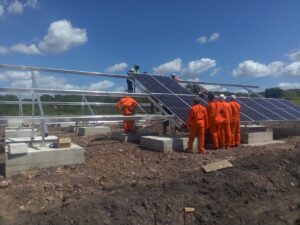
This energy crisis is not an isolated CoG problem; It is a reality that affects the entire surrounding community. The need for a clean, affordable and reliable source of electricity was more urgent than ever, not only for the organization, but also for the families who depend on its services.
This initiative aims not only to alleviate the financial burden of the organization by installing a photovoltaic solar system of 42.8 kW and 40 kWh of storage capacity, but also to train the next generation of renewable energy technicians.
The first phase of the project has focused on reducing CoG’s electricity bills, which have been a significant obstacle to its self-sufficiency. With the use of batteries for energy storage, the organization hopes to establish a partially independent power supply, freeing up resources for other community projects.
In a strategic decision that reflects its sensitivity to the needs of the community, Casa do Gaiato (CoG) has chosen to prioritize the residential area in the event of network blackouts. 40 kWh backup batteries are connected exclusively to this area, allowing a longer power supply in critical situations. This choice highlights the humanitarian approach of the organization, which considers the residential area as the most critical compared to the productive area.
To ensure the success of the project, CoG has worked closely with us as an engineering cooperative specialized in renewable energies. Since the award of the contract, both parties have closely monitored the activities carried out by the subcontractor, holding regular biweekly meetings until the completion of the project.
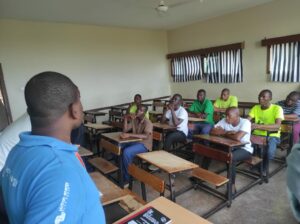
But this initiative goes beyond the simple installation of solar panels and batteries. The project in CoG is not only focused on short-term solutions. We understand that the sustainability of the installed system also depends on the training and education of the people who will take care of it. For this reason, an educational component has been incorporated into the project, offering theoretical and practical training in photovoltaic solar systems to young people who reside in its facilities. This training is not limited to CoG residents; it also extends to young people from neighboring villages, with the assistance of the Fundação Encontro.
That is why we think that the impact of this initiative could be transformative on several levels. This is not only the first project of its kind in the region, but also serves as a model for future programs in the field of renewable energy. Through collaboration with local authorities, CoG and the Fundação Encontro aspire to make this initiative a starting point for a green energy revolution in the community.
That is why the main objectives of the plan are doubly impactful: on the one hand, to provide CoG with a more affordable and sustainable electricity supply, and on the other, to train a new generation of professionals in the field of renewable energies. This is a gamble for the future that could be game-changer not only for CoG, but for the entire region.
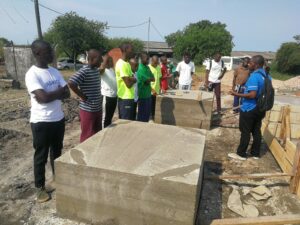
With an estimated annual saving of €3,500 in electricity bills and an educational impact that extends beyond its classrooms, Casa do Gaiato (CoG) is establishing a new paradigm in the use of renewable energies and education in Mozambique. This pioneering project has not only improved the financial sustainability of the organization, but has also opened up new learning avenues and job opportunities for young people in the community.
During the three months since its implementation, the photovoltaic installation has proven to be a resounding success. The annual saving of €3,500 is equivalent to the cost of university studies for three students, a significant contribution to CoG’s self-sufficiency. In addition, the backup system has been crucial in keeping operations uninterrupted, even during network blackouts that previously paralyzed the organization’s activities.
But the project goes beyond numbers. In the words of Arlindo Gabriel Baptista, professor of physics and computer science at CdG, this initiative has enriched the school curriculum, allowing him to introduce discussions on renewable energies in class. Baptista hopes this experience can lead to a vocational training course in photovoltaics at the school.
Rosa Francisco Anakondia, one of the students who participated in the training, reflects the transformative impact of the project. At the age of 24, Rosa has discovered a passion for renewable energy and aspires to a career in this rapidly expanding field. “I learned that it’s never too late to learn something,” says Anakondia, also highlighting her contribution to dismantling gender stereotypes in technical areas.
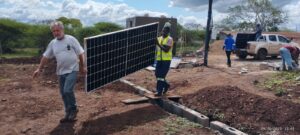
The impact of the project has been so important that work has begun on a 2nd phase of expansion of the photovoltaic installation in the area of La Fazenda, the Casa do Gaiato farm.
With this project, CoG has not only set a new standard in the use of renewable energy, but has also created a replicable model that could be the key to a sustainable energy revolution throughout the region.
Azimut World: international development cooperation area
